
British Real Photograph postcard. Photo: Metro-Goldwyn-Mayer Pictures (MGM).
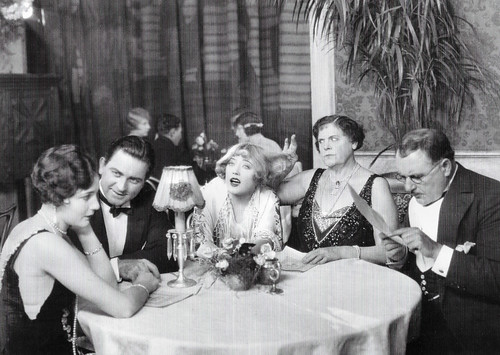
Promotion card for Il Cinema Ritrovato, Bologna, 2017. Photo: Marion Davies (middle), Jane Winton, Orville Caldwell, Marie Dressler and Dell Henderson in The Patsy (King Vidor, 1928).
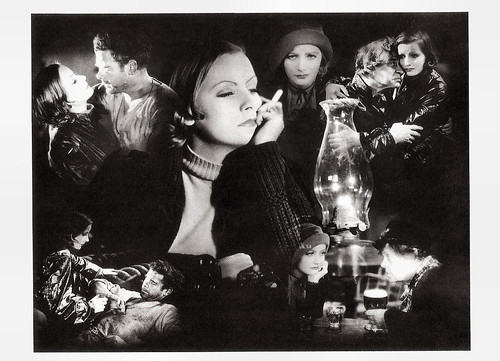
Swiss postcard by News Productions, Baulmes, no. 56490. Photo: Cinémathèque Suisse / Metro-Goldwyn-Mayer. Greta Garbo, Charles Bickford and Marie Dressler in Anna Christie (Clarence Brown, 1930). Design: Clarence Sinclair Bull, 1930.
Known for her hilarious facial expressions, seriocomic reactions, and double takes
Marie Dressler was born Leila Marie Koerber in Cobourg in the Canadian province of Ontario, in 1868. She was one of the two daughters of Anna (née Henderson), a musician, and Alexander Rudolph Körber, a former German officer and music teacher.
Her father was the organist at St. Peter's Anglican Church in Cobourg, where as a child Marie would sing and assist in operating the organ. The Koerber family eventually moved to the United States, where Alexander Koerber is known to have worked as a piano teacher in the late 1870s and early 1880s.
At 14, Marie left home and entered the theatre. Dressler adopted the name of an aunt as her stage name because her father objected to her using the name Koerber. She built a career in travelling theatre troupes, where she learned to appreciate her talent for making people laugh.
In 1892, she debuted on Broadway in 'Waldemar, the Robber of the Rhine', written by Maurice Barrymore, which only lasted five weeks. In 1896, Dressler landed her first starring role as Flo in George Lederer's production of 'The Lady Slavey' at the Casino Theatre on Broadway, co-starring British dancer Dan Daly. It was a great success, playing for two years at the Casino.
Dressler became known for her hilarious facial expressions, seriocomic reactions, and double takes. With her large, strong body, she could improvise routines in which she would carry Daly, to the delight of the audience.
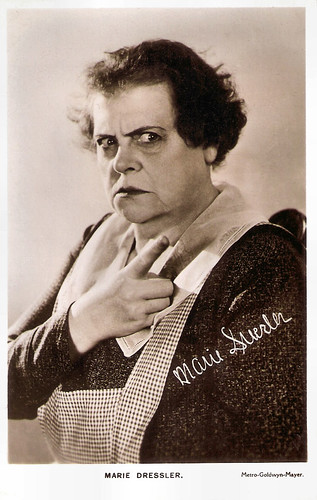
British postcard in the Film-Kurier Series, London, no. 31. Photo: Metro-Goldwyn-Mayer (MGM). Marie Dressler in Christopher Bean (Sam Wood, 1933).

British postcard in the Filmshots series by Film Weekly. Photo: M.G.M. Wallace Beery and Marie Dressler in Tugboat Annie (Mervyn LeRoy, 1933).
She was blacklisted and suffered great material hardship for years
In 1900, Marie Dressler married theatrical manager George Hoeppert. Her marriage to Hoeppert gave Dressler U.S. citizenship. They had a daughter who died in infancy and the couple divorced in 1906. In 1907, she met Maine businessman James Henry "Jim" Dalton, who was married and she went to live with him. They would stay together until his death in 1922.
The two moved to London, where Dressler performed at the Palace Theatre of Varieties for $1500 per week. Back in the US, Dressler starred in the play 'Tillie's nightmare' (1910) by A. Baldwin Sloane and Edgar Smith. A few years later, Keystone producer Mack Sennett made a film version, Tillie's Punctured Romance (Mack Sennett, 1914). The comedy which also starred Mabel Normand, Charlie Chaplin, and the Keystone Kops, became the first film Dressler starred in.
It was also the first full-length, six-reel slapstick comedy ever. In the following years, she made several comedies including two Tillie sequels but she mostly worked on stage in New York City. During World War I, along with other celebrities, she helped sell Liberty bonds. In 1919, she helped organise the first union for stage chorus players. For this, she was blacklisted and suffered great material hardship for years.
Dressler was reduced to living on her savings while sharing an apartment with friend Nella Webb. Only many years later, the then 59-year-old Dressler made a comeback. Thanks to director Allan Dwan, Dressler played a supporting role in The Joy Girl (Allan Dwan, 1927) starring Olive Borden. Her good friend, screenwriter Frances Marion, who had cared for her during the hard years, then got her a contract with the MGM studio.
Her first MGM feature was The Callahans and the Murphys (George W. Hill, 1927), a rowdy silent comedy co-starring Dressler with another former Mack Sennett comedian, Polly Moran, as a couple of feuding tenement housewives. Dressler and Moran formed a popular screen couple in several films. Another success was the hilarious screwball comedy The Patsy (King Vidor, 1928) in which she played Marion Davies' mother. Her popularity rose and eventually, the advent of sound film made her a major film star.

British postcard. Photo: Metro-Goldwyn-Mayer (MGM).

British postcard in the Filmshots series by Film Weekly. Photo: M.G.M. Marie Dressler, Wallace Beery and Paul Hurst in Tugboat Annie (Mervyn LeRoy, 1933).
No pretensions and a delightful sense of humour
Although Greta Garbo was the star of Anna Christie (Clarence Brown, 1930), Marie Dressler also received rave reviews for her role as a bitter old prostitute in the film. Dressler's rumbling voice could handle both sympathetic scenes and snappy comebacks. In 1931, Dressler received an Academy Award for Best Actress for her role in Min and Bill (George W. Hill, 1930) alongside Wallace Beery. Beery was a good 20 years younger than Dressler but played her husband in the film. Min and Bill (1931) was one of the most financially successful films of the year. After this success, Dressler and Beery's footprints were inscribed on the cement forecourt in front of the Chinese Theatre in Hollywood with the words "America's New Sweethearts, Min and Bill".
She was nominated again in 1932 for her role in Emma (Clarence Brown, 1932) but ultimately did not win the Oscar this time. In 1933, she starred in the popular comedy Dinner at Eight (George Cukor, 1933), the film adaptation of a successful Broadway play by George S. Kaufman and Edna Ferber. She played an ageing but vivacious former stage actress alongside John Barrymore, Jean Harlow and Wallace Beery.
Tugboat Annie (Mervyn LeRoy, 1933), which reunited her again with Wallace Beery, became one of the most successful films of the year for MGM. Marie was at the top of her career. For the years 1932 and 1933, the Motion Picture Herald Box Office Ranking, which was based on annual representative surveys of US cinema operators, listed her as the country's highest-grossing star.
In early 1934 she was diagnosed with terminal cancer. Louis B. Mayer gave her a new, financially lucrative contract to bolster her morale. Coming to movie stardom late, Dressler had no pretensions and a delightful sense of humour. Once, when visiting William Randolph Hearst's California palace San Simeon, a monkey pelted her with some of his excrement. Dressler responded: "Oh, a critic!"
At the age of 65, Marie Dressler died of cancer in 1934 in Santa Barbara, California. She was buried at Forest Lawn Memorial Park Cemetery in Glendale. The first of her two autobiographies, 'The Life Story of an Ugly Duckling', was published in 1924. A second book, 'My Own Story', "as told to Mildred Harrington", appeared a few months after her death. Since 1960, a star on the Hollywood Walk of Fame, at 1559 Vine Street, commemorates the actress.
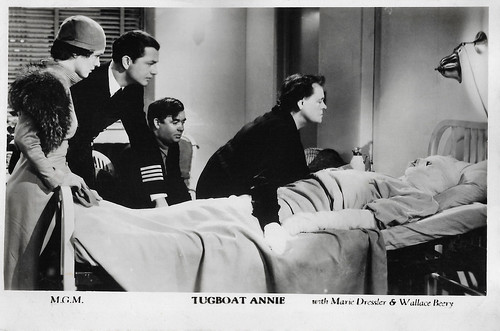
British postcard in the Filmshots series by Film Weekly. Photo: M.G.M. Maureen O'Sullivan, Robert Young, Paul Hurst, Marie Dressler and Wallace Beery in Tugboat Annie (Mervyn LeRoy, 1933).
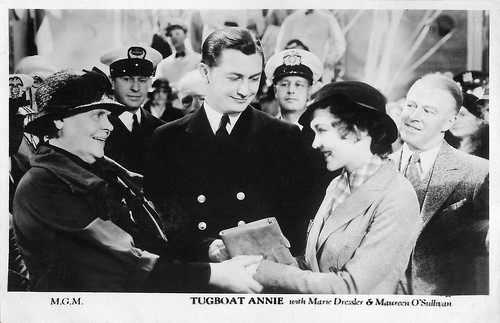
British postcard in the Filmshots series by Film Weekly. Photo: M.G.M. Marie Dressler, Robert Young and Maureen O'Sullivan in Tugboat Annie (Mervyn LeRoy, 1933).
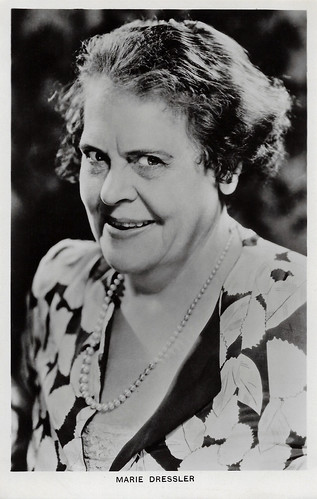
British postcard in the Picturegoer Series, London, no. 496a. Photo: Metro-Goldwyn-Mayer (MGM).
Sources: Wikipedia (Dutch, German and English) and IMDb.
No comments:
Post a Comment